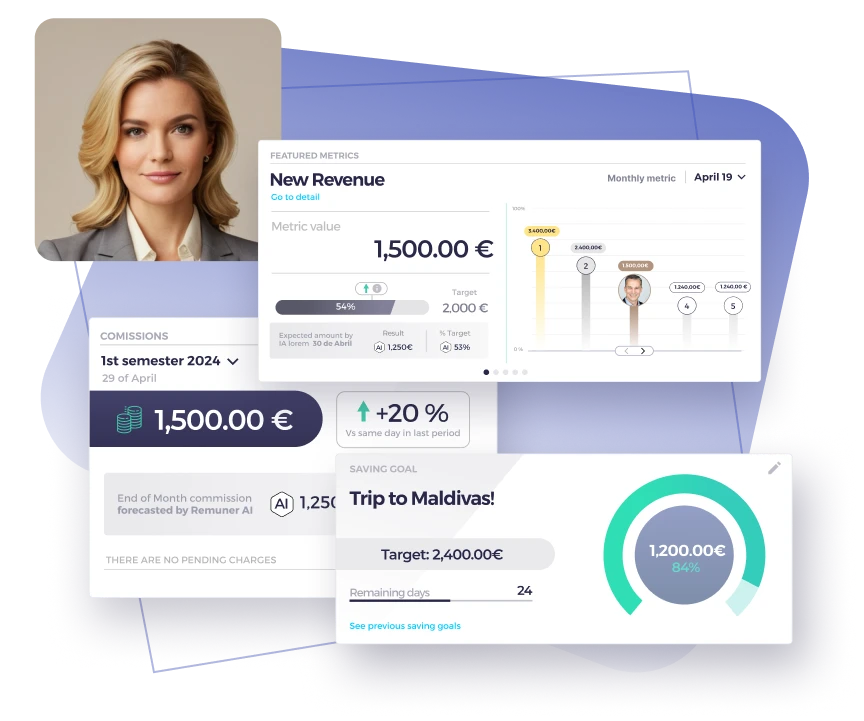Table of contents
Incentives move people more than memos. Yet many teams still run commissions in fragile spreadsheets that create errors, slow decisions, and drain trust. After joining the EU-Startups podcast, our CEO Sergio González explained to Marcin Lewandowski why incentives deserve to be treated like a core system—and how better design changes behavior and performance.
Why Incentives Matter More Than You Think
Sales incentives are one of the most powerful levers for growth. They turn strategy into behavior: what we pay for is what people repeat. When incentives are clear, transparent, and aligned with company goals, teams move faster in the right direction. When they’re opaque or misaligned, they create shadow accounting, sandbagging, and costly mistakes.
As Sergio put it on the show, “Incentives drive behaviour… and are completely underused.”
In the episode, Sergio highlights a common pattern: public companies still running commissions in spreadsheets, with horror stories of five-figure overpayments going unnoticed. That’s not just a tooling issue—it’s a system failure. If the plan design, calculation engine, visibility, and iteration loop aren’t integrated, the organization pays a trust tax every month.
The Three Silent Killers Of Incentive Plans
1) Spreadsheet Opacity → Shadow Accounting. When reps don’t understand how earnings are calculated, they build their own trackers. This doubles work, increases disputes, and destroys confidence in the plan. Transparency isn’t a “nice to have”—it’s the foundation for motivation.
2) Misaligned Cycles And Caps. If you cap commissions mid-quarter, you quietly encourage your top performers to hold deals for the next period. Caps feel safe on paper, but they often push revenue away from the business when you need it most. Aligning sales and compensation cycles (and avoiding caps that punish excellence) prevents this leakage.
3) Slow Iteration From IT Bottlenecks. Plans evolve. Markets change. A good incentive system lets business owners adjust rules quickly without a long integration queue. When plan changes require tickets and developer time, you lose the ability to run controlled experiments and learn.
Design Incentives Like A System
Great incentive programs share five design traits. Use this as your checklist.
- Transparency By Default. Give every rep a live view of how each deal impacts earnings. Link every payout line to the rule that generated it. Real-time statements beat end-of-month surprises.
- Real-Time Calculations. If earnings update only after finance closes the books, you’ve already missed the coaching moment. Real-time math creates instant feedback loops—so reps can adjust behavior while it still matters.
- No-Code Plan Changes. Empower revenue and finance leaders to configure rules without waiting on engineering. Treat plans like products: versioned, reviewed, tested, and shipped.
- AI Assistance And Simulations. Let reps run “what-if” scenarios and managers coach with recommendations. Nudges like “You’re two enterprise logos away from unlocking a 1.5x multiplier” change behavior more effectively than static PDFs.
- Global Readiness. Multi-currency, regional compliance, and flexible approval flows remove the friction that slows down scale. If your incentive system can’t handle global realities, go-to-market speed suffers.
From Payouts To Performance: A Simple Blueprint
Most teams ask, “How do we pay?” Better teams ask, “How do we drive the right behavior?” Use this blueprint to move from payouts to performance.
1) Start With The Behavior You Want. Define three to five behaviors that most predict success in your model: for example, closing multi-year contracts, landing the ideal customer profile, or expanding net revenue retention. Connect each behavior to a measurable KPI.
2) Reward Velocity And Quality. Speed matters, but not at the expense of deal quality. Combine accelerators for cycle time with quality gates (margin thresholds, ICP fit, churn risk) so reps don’t chase the wrong logos.
3) Align Timing With Reality. Make sure commission periods, recognition rules, and clawbacks map to your sales cycle. If you sell enterprise deals across quarters, recognize milestones (for example, signature) with clear, auditable rules—then true-up on activation or cash.
4) Remove Caps, Add Guardrails. Caps are a blunt tool for risk. Instead, deploy tiered accelerators with guardrails: quality checks, deal-desk approvals, and exception workflows. Reward outliers who sell the right deals the right way.
5) Deliver Line-Of-Sight. Every rep should answer two questions at any moment: “What am I on track to earn?” and “What would change that this week?” Charts, alerts, and simulations create that line-of-sight.
6) Iterate Monthly. Treat incentives like a product backlog. Review what worked, ship small plan improvements, and announce changes with examples. The combination of real-time data and short iteration cycles compounds.
Common Anti-Patterns To Avoid
The Spreadsheet Maze. Multiple files, manual consolidations, hidden formulas. This is how errors creep in and disputes multiply. You save hours by abandoning it; you save trust by never going back.
“One Plan To Rule Them All.” Different motions need different levers. Hunters, farmers, partnership managers, and BDRs respond to different incentives. Give each motion a plan that amplifies its role.
Paying For Activity When Outcomes Matter. Activity incentives can help early reps build habits, but they should ladder to outcomes. If you pay forever for dials, you’ll get dials—not revenue.
Changing Rules Mid-Period. Nothing erodes trust faster. If you must change, version the plan, communicate clearly, and apply changes at the next period start with examples and simulations.
Mini-Scenarios: What Better Design Unlocks
Removing Caps On Large Deals
A B2B SaaS company removes a quarterly cap and adds a high-value multiplier for multi-year contracts with healthy margins. Result: top reps stop deferring enterprise deals, quarter-end bunching fades, and revenue smooths across the year. This aligns with Sergio’s point: caps often shift deals into the future and quietly hurt growth.
Introducing “What-If” Simulations
Reps can model deals and see how product mix, term, and payment structure change earnings. Managers coach proactively: “Pull this deal into this month to unlock your accelerator.” Conversion climbs because the comp plan becomes a navigation tool, not a mystery.
Real-Time Dispute Prevention
Live statements trace each number to a rule and a data source. Reps stop filing end-of-month tickets because they can self-audit. Finance closes faster with fewer adjustments. Trust rises because visibility is built-in.
Why Now
The incentive stack is modernizing fast. Data is unified. Plan design moved from code to configuration. AI turns historicals into nudges. And companies are investing accordingly. Earlier this month, we announced a new seed round to accelerate exactly this mission—turning incentives into a growth lever with automation, intelligence, and speed.
What this means for customers: faster plan experiments, deeper AI coaching, and more global features out of the box. When incentives work like a system, you stop firefighting payouts and start compounding performance.
A Quick Self-Audit You Can Run This Week
Use these questions in your next revenue, finance, and ops sync:
- Clarity: Can every rep explain in one sentence how to unlock their next accelerator? If not, what needs to be simplified?
- Visibility: Do reps and managers have real-time earnings and forecasted payouts tied to pipeline changes?
- Alignment: Do any rules incentivize delaying or discounting the wrong deals? Where might caps or recognition timing push revenue into the next period?
- Iteration Speed: How long does it take to ship a plan change today? Can revenue leaders run controlled experiments without engineering work?
- Trust: How many disputes did we process last period? What percentage came from unclear calculations?
Bringing It All Together
Incentives are not a finance back-office task; they’re your behavior engine. Design them like a system—transparent, real-time, configurable, and coached by AI—and you turn compensation into a competitive advantage. As Sergio said on the podcast, the goal isn’t just bigger paydays; it’s smarter ones that move the business.





